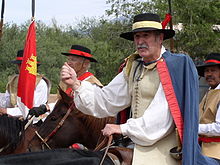Tubac Presidio State Historic Park
This article needs additional citations for verification. (February 2022) |
| Tubac Presidio State Historic Park | |
|---|---|
 Entrance to Tubac Presidio State Historic Park | |
| Location | Santa Cruz, Arizona, United States |
| Coordinates | 31°36′41″N 111°2′45″W / 31.61139°N 111.04583°W |
| Elevation | 3,500 ft (1,100 m) |
| Established | 1958 |
| Named for | Presidio San Ignacio de Tubac |
| Visitors | 6,620 (in 2022)[1] |
| Governing body | Arizona State Parks |
| Website | https://www.tubacpresidio.org/ |
Tubac Presidio State Historic Park, located in Tubac, Arizona, US, preserves the ruins of the Presidio San Ignacio de Tubac and various other buildings, thereby presenting a timeline of European settlement in this Southern Arizona town. The park contains a museum, a number of historic sites, an underground archeology exhibit displaying the excavated foundations of the Tubac Presidio, and a picnic area. Various cultural events are held on-site throughout the year, including Anza Days (October), Los Tubaqueños living history presentations (Sundays from October through March), archeological tours, and nature walks. Until recently, the park was administered by Arizona State Parks but is the first park in the Arizona state park system. As a result of budget cutbacks, the Tubac Presidio was scheduled to be closed in 2010, but was rescued by local residents and the Tubac Historical Society. It is now operated by The Friends of the Presidio and staffed with dedicated volunteers.[2]
History
As the Spanish Empire attempted to expand into the frontiers of

Threatened by the establishment of a
Tubac became part of an
Park facilities and events
The centerpiece of the exhibits at Tubac Presidio State Historic Park is the underground display of the presidio's foundations. Excavated in 1974 by archeologists from the University of Arizona, portions of the presidio's foundation and walls can be viewed by visitors. Visitors may also enter the furnished 1885 schoolhouse, complete with desks, chalkboards, and a potbelly stove. Other buildings on site include the 1914 Otero Hall, which houses exhibitions, a visitor center, the Rojas House, occupied by the same family for about one hundred years, and a museum with displays from the various historic periods of settlement in Tubac, including American Indian (pre-1752), Spanish Colonial (1752–1821), Mexican Republic (1821–1854), and Anglo Territorial (1854–1912). Adjacent to the park grounds is St. Ann's Church, which was built on the ruins of the former Iglésia de Santa Gertrudis, and the trailhead of the Tubac-to-Tumacácori portion of the Juan Bautista de Anza National Historic Trail.
Every October, the park hosts Anza Days to commemorate the arrival of Juan Bautista de Anza at the Tubac Presidio. Costumed actors on horseback arrive from nearby Tumacácori and discuss de Anza's trip to San Francisco. Other presentations at the weekend event include actor portrayals of the time periods during which Tubac has been active as well as mariachi music and cowboy rope tricks.
Gallery
-
Exterior of the Old Tubac Schoolhouse
-
Interior of the Old Tubac Schoolhouse
-
Interior of Museum at Tubac Presidio State Historic Park
-
Patio Exhibits at Tubac Presidio State Historic Park
-
Adobe Ruins of Tubac Presidio. Above-ground ruins date from the early 1900s while below-ground foundations are from the mid- to late 1700s
-
St. Ann's Church (adjacent to park grounds) built on the ruins of the former Iglésia de Santa Gertrudis
-
Underground archeology exhibit of the foundation of the Tubac Presidio
References
- ^ "Monthly State Parks Visitation Report" (PDF). Arizona Office of Tourism. December 2022.
- ^ Arizona State Parks (December 2007). "Arizona State Parks 2006–07 Annual Report" (PDF). Archived from the original (PDF) on 2011-05-26.








